Now & New
TeamLab Exhibition at Fukuyama Castle: Hatching New Life Following Restoration
Fukuyama is a city that often gets overlooked in spite of its historical significance. Of particular note is Fukuyama Castle, which is known for being one of the principal fortifications of Bingo Province (a precursor to Eastern Hiroshima Prefecture), for having the ninth-tallest castle keep of existing castles in the nation, and for having a castle keep closer to a train station than any other in all of Japan. Although the present Fukuyama Castle is a reconstruction that was erected in 1966, construction of the original keep was completed in 1622, and thus 2022 marked the 400th anniversary of the Fukuyama Domain. In preparation for commemorating such a momentous occasion, the main keep underwent renovations at the end of January 2021, only to open up to the public again on the 28th of August, 2022, the day on which Mizuno Katsunari, the initial lord of Fukuyama Castle, officially reported the completion of the castle’s construction to the shogunate.
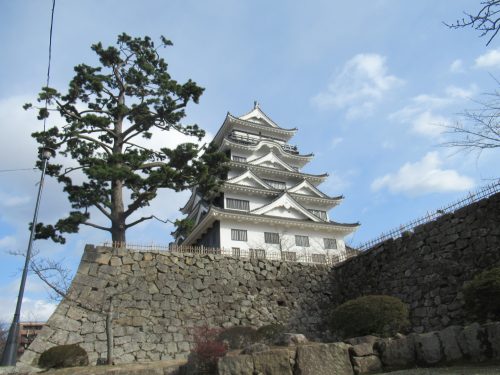
To tell the truth, I had been dying to check out the newly renovated Fukuyama Castle ever since last summer but could never open up time in my schedule. I could’ve gone during Fukuyamanime in October, but reservations were necessary on weekends (I didn’t make one) and I chose to chase down cosplayers instead. It wasn’t until January that I finally found a weekday to visit, and lucky for me, that was when TeamLab (チームラボ – Chiimu Rabo) happened to be holding an illumination event on the site of the castle! TeamLab is an organization that puts on amusing, glow-in-the-dark, hands-on exhibitions all over the country. Previously, in April of 2019, they set up an enormous array of inflatable eggs on the grounds of Hiroshima Castle, and nearly four years later, those same eggs touched down in Fukuyama from December 2022 to the last weekend of January 2023. By touring the castle keep during the day and checking out the TeamLab event in the evening, I was able to knock out both items in one fell swoop!
Afternoon Approach
As I planned to visit on the last Friday of January, I knew that I wouldn’t need a reservation and that the castle wouldn’t be crowded since the winter school holidays had long since ended. This meant that rather than blow money on a Shinkansen ticket, I could take my sweet time getting to Fukuyama via the JR Sanyo Green Line, which takes about 90 minutes and involves one transfer at Itozaki Station. I got to Fukuyama at about a quarter to one in the afternoon, so I made a quick detour to Jiyuken, a locally-famous eatery, for a brief lunch. The inside of the restaurant was full of workers on their lunch break as well as senior citizens casually enjoying a typical Friday; I plopped myself at the counter and quickly ordered a set meal with oden—the stewed recipe for which Jiyuken is most famous—as the main dish.
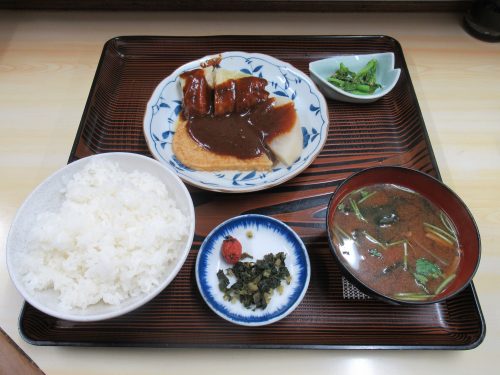
Usually, when ordering oden, the customer can choose which foods from the grand pot he or she wants to eat, but for this set meal, the establishment simply surprised me with three items on a plate with a dark miso sauce drizzled on top. Looks like today’s oden pick was a cabbage roll filled with ground pork and cut into bite-size pieces, half a slice of daikon radish, and a thin slice of fishcake. That was accompanied by a bowl of steamed rice, a side dish of chilled, marinated greens, a bowl of red miso soup, and a dish of pickled mustard leaves and a pickled plum. I was tempted to stay as long as I could to savor the rich flavor of everything and almost wanted to order more, but I could hear Fukuyama Castle calling my name so I left it at that.

There are several avenues of approach to Fukuyama Castle; the quickest one is the one to the south, but it involves some steep inclines and a lot of stairs so physically inept visitors may struggle with that entrance. There was a sign just outside the north exit of Fukuyama Station indicating a barrier-free route to the castle keep via the north entrance, which I decided I would try for the first time. This approach also takes tourists past Sanzo Inari Shrine (pictured above), so before entering the castle grounds I decided to say a quick prayer here. The first thing I noticed when entering the shrine grounds was the sleek, modern, electronic information plaque that has recently been popping up in shrines across Japan. This digital format allows the plaque to display more information than it would otherwise be able to, such as information on the shrine itself, instructions on how to pray, and a map of the surrounding area.
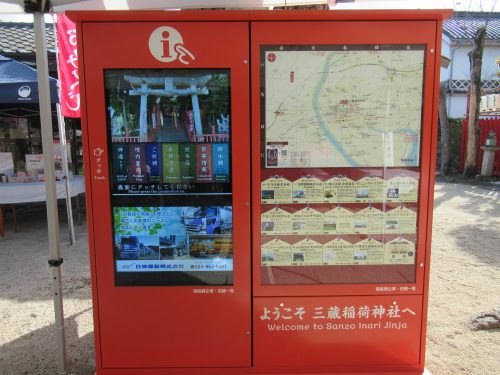
Sanzo Inari Shrine’s main altar was located to the right of the above plaque and flanked on both sides by racks where a bunch of omikuji (おみくじ – paper fortunes) were tied. These omikuji were sold at vending machines under a tent beside the main prayer hall, so I bought one for myself, read the fortune, and tied it to a rack. People tend to leave the fortune at the shrine in such a manner whether the fortune indicated good or bad luck; my fortune was moderately lucky, so I left it there with the enshrined gods in hopes that it would positively improve my life somehow in the following days.
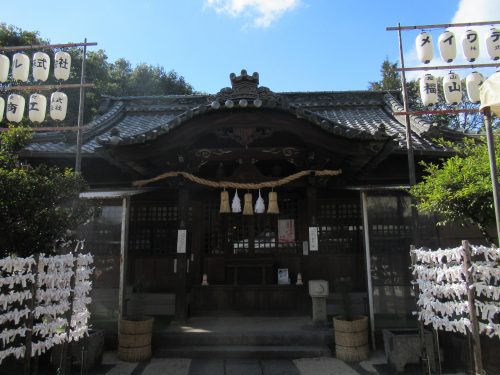
New and Improved Castle
I exited the shrine, continued along the route past an old air raid shelter large enough to only protect one person, and walked into the north entrance to Fukuyama Castle when I caught sight of the first noticeable change to the keep’s appearance. The north face of the keep was now black while the other three faces stayed white as they were. After that, I encountered the ginormous inflatable eggs sitting in the castle plaza, waiting for the sun to set so they could finally shine. Time was of the essence, however, so I briskly made my way to the ticket vending machine, entered the castle keep, and was greeted by an introductory movie that gave tourists a crash course on the history of the Fukuyama Domain.

About that black wall earlier: only the north face of the keep was covered in iron plates as it was the only side without a moat. The moat surrounding the south, east, and west sides of the castle has since been filled in, but the recent refurbishments finally made the north wall ironclad for the sake of historical accuracy. The museum inside the keep was chock full of other historical tidbits and artifacts, but only a fraction of them allowed photography, such as the shachi statues above. I had been to Fukuyama Castle before the renovations began, and though I could see a major overhaul in the interior design and items on display, the most impactful improvement in my eyes would have to be these new, virtual warrior experiences on the second floor.
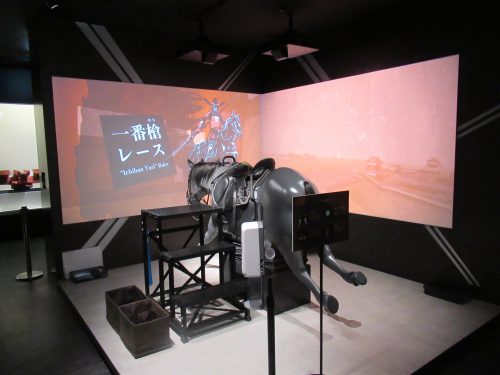
The first one I tried was the “Ichiban Yari” Race, which had easy and regular modes so that kids and adults could enjoy the ride. “Ichiban Yari” translates to “the first spear,” which refers to the soldiers’ desire to be first on the battlefield and spill the first blood. Visitors mount the horse and steer it in a virtual castle siege, avoiding obstacles and gaining power-ups to boost the noble steed’s speed. Elsewhere on the second floor is a marksmanship game wherein participants shoot at a virtual target with a matchlock gun; Mizuno Katsunari accomplished this feat himself at the age of 87, not long before his passing.
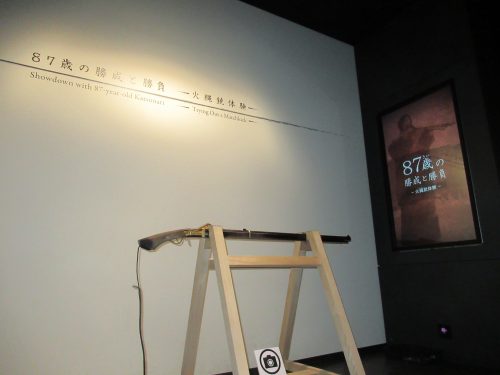
At the top floor was the observatory where a suit of samurai armor was on display as a photo prop. Inside this room, tourists can take a photo with this suit of armor, gaze upon the world’s smallest model of Fukuyama Castle (it’s almost microscopic) and admire a mosaic of the keep to celebrate the Fukuyama Domain’s 400th birthday.
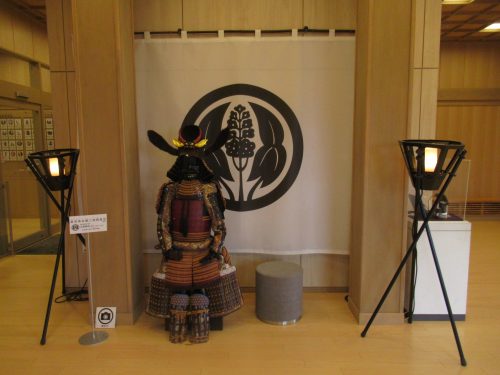
Tourists can also step outside to enjoy views of the city from the north, south, east, and west sides. The most interesting view that day was inarguably the view from the south side, where a forest of gargantuan eggs filled the space between buildings. As the TeamLab exhibition would only begin at night after the castle closed for the day, I decided to leave for the time being and return after sunset.
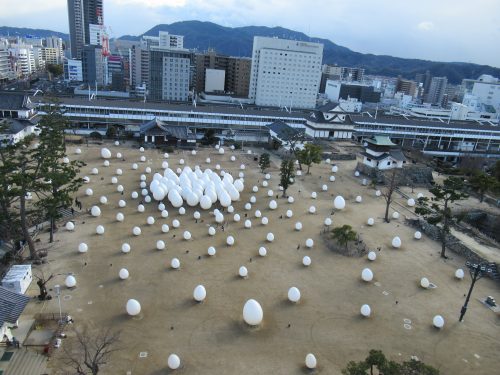
Moment of Joy: Flash Blizzard
Cold as it was outside, I tried to kill time by walking around the city center, checking out nearby shops and restaurants. Then, out of the blue, a flurry of snow blew in and made the winter weather much more enjoyable. I was so astounded by the amount of snowfall, even for just a few minutes, that I actually forgot to take out my camera to capture the magical moment. Although the petit blizzard was gone in a flash, it set the mood for the TeamLab illumination to come, and got me hankering for a bowl of Fukuyama ramen, which I planned to enjoy right outside Fukuyama Station after the event.
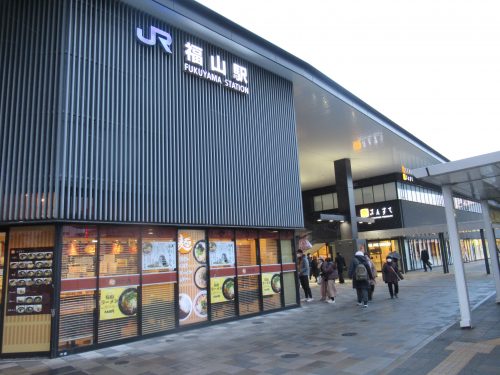
Eggs-ellent Artwork
Finally, dusk came, and I made my way back around the north entrance of the castle, which was now the only entrance to the TeamLab event. Visitors can buy tickets on-site, but it’s more convenient to reserve and purchase a ticket on the tabiwa app, which I simply showed to be let into the event. The first egg-related display was this rectangular arrangement featuring little, glowing eggs sitting on some foundation stones. This space alone was full of kids playing with the eggs, which changed color when touched.
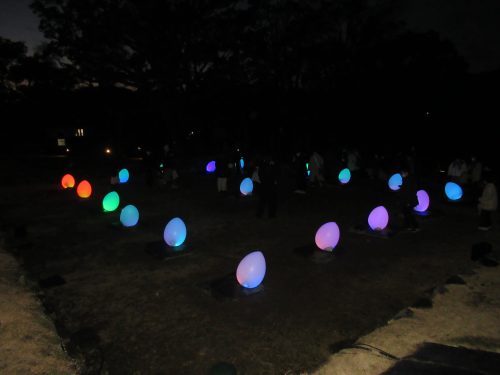
I then progressed to the plaza beside the main keep, where the biggest of the eggs stood. The eggs were huge even for adult humans, so children have a risk of getting lost when entering the ovular jungle. It also helped to duck into the restrooms that night, because regardless of whether I had to go, that brief moment indoors saved my fingers and toes from freezing off due to prolonged exposure to the cold.
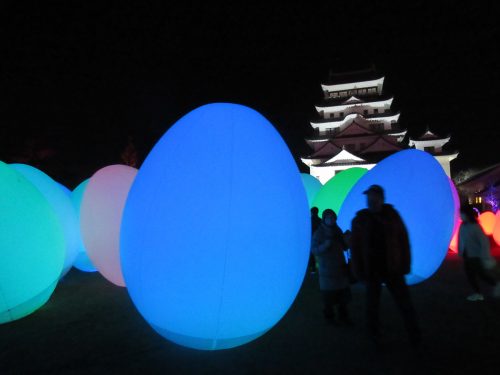
The next segment of the exhibit took me to the foundation stone walls, where there were projection mapping shows. This one show featured clusters of flowers shaped like safari animals, complete with realistic animal cries. I had a lot of fun trying to guess what all the animals I saw were, and so did every other passerby.
There were other projection mapping shows based on calligraphy or absurd ideas such as a procession of bunnies overseen by frogs in chariots. Near the end of the exhibit was this station where children could draw and color their own samurai and bring them to life on a projector screen. Everyone’s characters would interact with each other by talking, fighting, and occasionally dancing to the background music.
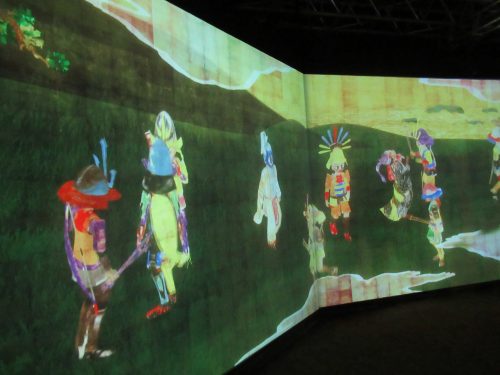
Meals on Wheels
Upon exiting the TeamLab event, I found myself in a plaza west of the castle keep where a row of food trucks was lined up. I was tempted to try so many things, but since I wanted Fukuyama ramen from that station restaurant, I settled for a small snack: deep-fried three leaf arrowhead tubers, which are allegedly a not-so-well-known Fukuyama specialty. Diners could sit down inside one of the tents—which are equipped with heaters—to take their meals, which provided some much-needed respite from the frigid temperatures outdoors.
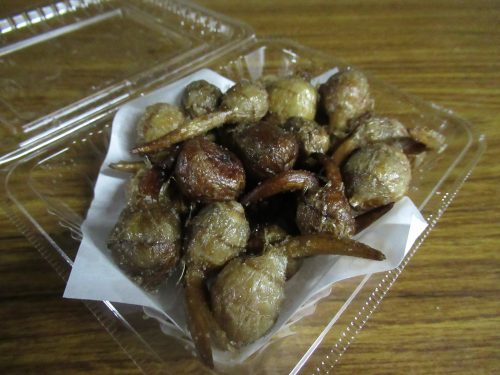
On the other side of said tents were some sculptures made of bamboo that glowed with electric candlelight. There were four of them, each made by a class of a different school in Fukuyama, and I must admit, all of these kids truly outdid themselves. I actually got my pictures of these beauties before entering the TeamLab event, but they were even lovelier when the sky was pitch black.
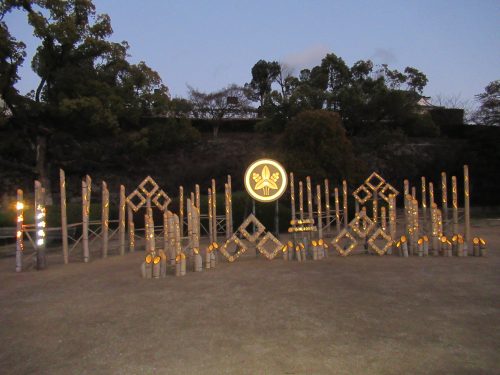
After finishing my snack, I doubled back to Fukuyama Station where I got my hands on my actual meal for the night, Fukuyama ramen. Eager to chow down, I purchased a ticket from the vending machine and handed it over before taking a seat and awaiting my piping hot dinner. At last it came, a delicious concoction of noodles, broth, pork slices, bean sprouts, green onions, bamboo shoots, and half of a hard-boiled egg. This bowl of hearty goodness warmed me to my core, but what made this moment taste even better was knowing I was the last customer in the store, which allowed me to savor my ramen in solitude.

The newly refurbished Fukuyama Castle has been attracting a lot more tourists since the re-opening last August, and it goes without saying that it will continue to do so in the coming months. In addition, this recent TeamLab event only served to bolster the castle’s fame and profits, and brought some semblance of nightlife to Fukuyama, which still has this tendency to go to sleep at night, as it were. Fukuyama Castle’s unmatched accessibility means there is absolutely no excuse for tourists visiting Hiroshima to miss out on it, and if you can hatch a plan to visit it in its newest, most historically accurate state, then bingo! You too can bear witness to feudal history reborn in the modern era, and contribute to Fukuyama’s new life as an increasingly popular tourist destination in the prefecture.
Written by the Joy in Hiroshima Team
